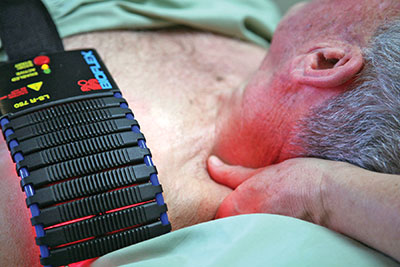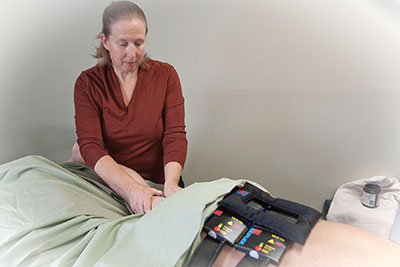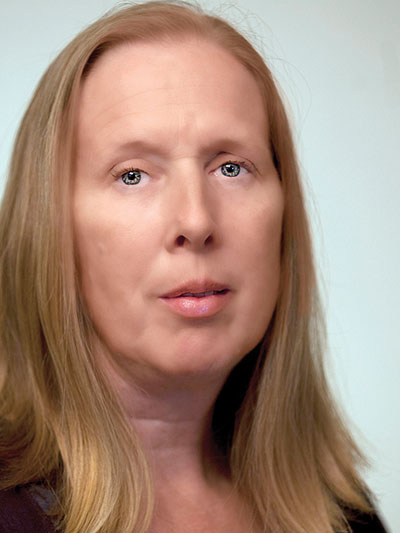
Features
Practice
Technique
Laser Therapy in the Massage Practice
After 32 years in practice, working with chronic conditions, I didn’t think I would ever see a therapy so amazing.
June 25, 2013 By Catherine Wilkinson RMT
After 32 years in practice, working with chronic conditions, I didn’t think I would ever see a therapy so amazing. A year later and thousands of laser minutes applied, I am still awed by the conditions I have treated with success. Whether they have come to me after six months or 30 years of pain, all clients have walked away in wonder because something finally worked.
WHAT IS LASER THERAPY?
Low Level Laser Therapy (LLLT) is a non-invasive, pain-free, light-based therapy that uses red and infrared light to target inflamed, injured and diseased tissues. Photons of light stimulate ATP production, thereby accelerating the healing process.1 Compared to traditional treatments, patients recover from musculoskeletal and peripheral nerve injuries with less scar tissue, accelerated cell regeneration and improved function.2,3,4
 |
|
| The flexible arrays wrap around joints and limbs for more effective contact and permit hands-free treatment, allowing the therapist to continue massage, thus integrating the two therapies and enhancing treatment outcome.
|
BENEFITS OF LLLT FOR PATIENTS
- Non-surgical pain relief option
- Non-invasive and non-toxic
- Eliminates pain
- Accelerates healing
- Reduces inflammation
- Eligible for full or partial coverage by extended insurance coverage
- Clinically proven
- No known adverse effects
- Cost-effective option
BENEFITS OF LLLT FOR PRACTITIONER
- 85-95 per cent success rate = more patient satisfaction
- Raises respect and reputation of practitioner
- Increases medical referrals
- Increases revenue
- Extends longevity of practice
- Decreases wear and tear on your body and hands
APPLICATION
Similar to massage recommendations, the first three to five LLLT treatments are done at closer intervals to each other, preferably one to two days apart. Depending upon the patient’s response and the protocols indicated for that patient, I recommend two times a week for three to five weeks.
INDICATIONS FOR LLLT
Soft Tissue and Sports Injuries
- Ligament/tendon/muscle tears
- Knee dysfunction (meniscal/ligamentous tears)
- Fractures
Repetitive Stress Injuries
- Carpal Tunnel Syndrome
- Rotator cuff injuries
- Epicondylitis
Inflammatory Conditions
- Tendonitis (supraspinatus/achilles, etc.)
- Plantar fasciitis
- Rheumatoid arthritis
Back Problems
- Degenerative osteoarthritis
- Spinal stenosis/sciatica
- Disc herniation
- Myofasciitis
Other Conditions
- Neuropathies
- Temporo-mandibular Joint Dysfunction
- Lymphedema
- Fibromyalgia
EASY-TO-USE LASER THERAPY SYSTEM
Choosing an easy-to-use system is important in order to successfully integrate laser therapy into a massage practice. The laser therapy system in my clinic is easy-to-use and uncomplicated. Treatments can be administered immediately after assessment. The user-friendly software has a library of scientifically developed and clinically tested protocols to use with a touch of the keypad. We can update the system when protocols for new conditions and pathologies are developed. We can also customize the protocols to the client conditions, and we receive this hands-on instruction during the Laser Therapy Certification Training.
The large and flexible arrays have 180 diodes of light and can contour to your client’s body. The flexible arrays allow us to wrap around joints and limbs for more effective contact. They also permit hands-free treatment, which allows us to continue massage to other areas of the body while laser is being applied, integrating the two therapies, and enhancing treatment outcome.
The laser therapy systems are portable and can be moved easily between treatment rooms. Depending on the manufacturer you go with, units may come with disposable plastic covers to protect and cover the arrays from oils and lotions. Some systems also allow portability outside the office for mobile home therapy. Clinical support is available seven days a week. The doctors and laser therapists who work within the manufacturer’s clinic are only a phone call away and available to answer any questions about the protocols or treatment customization. Trained technical personal are also available for inquiries about the equipment.
COMBINING MASSAGE AND LASER THERAPY
After 32 years of using only my hands in treatment, I had some adjustments to make. I needed to adapt my thinking to systemizing the treatment for optimal time utilization – I was up to the challenge.
Treatment plans using laser therapy and massage can be combined in several ways. You can apply the laser protocol first, and then follow with massage treatment for the prescribed condition. You can reverse the order by doing the massage treatment first, followed by the laser protocol. You can also do them simultaneously, blending the two. The order does not seem to make a difference to the overall outcomes.
To combine massage treatment with laser is similar to adding hydrotherapy to a massage treatment. One of the biggest challenges, when I combine the two therapies, is to utilize time effectively and provide the best treatment. You need to analyze your treatment by looking at the time frame of the chosen protocol and determine where you can massage while the arrays are on the treatment area. Massage and laser therapy complement each other, enhancing the overall treatment and bringing quicker and lasting results.
CASE STUDY 1
The patient is an 83-year-old farmer who injured his lower back in November 2002. He suffered from severe pain and a paralysis to left leg and foot, known as “drop foot.” Consultation with a neurosurgeon and neurologist offered no treatment or hope for recovery.
 |
|
| Another example of combining massage therapy treatment with laser therapy.
|
Diagnosis: Disc herniation with L5 left nerve root damage, causing decreased flexion of the left first toe and foot, decreased circulation and pain upon palpation of plantar area of the left foot because of nerve deterioration. A second injury, sustained in September 2012, included a muscle tear to the tibialis anterior. The second injury caused difficulty in walking, climbing stairs and general work on the farm. Laser therapy started eight months after second injury. The laser was applied for four consecutive days and subsequently two to three days a week for the treatment protocol. Laser was applied to two treatment areas to the lower back and lower left leg.
Progress with lumbar spine protocol: Within five treatments, the patient experienced return of normal circulation and decrease of pain in palpation of plantar surface of foot. Ten treatments increased movement in flexion of foot and resulted in no pain on palpation of foot; 15 treatments brought 80 per cent increased range of motion. All improvements have demonstrated regeneration of the L5 nerve function.
Progress with lower leg protocol: First five treatments decreased swelling and pain, 10 treatments brought increased ROM and no pain, 15 treatments normal ROM and return to normal activity.
CASE STUDY 2
The patient is a 52-year-old female massage therapist who had been involved in four MVAs with whiplash injuries. This resulted in radiation of pain through the neck and shoulder girdle and both arms as well as numbness down both arms, weakness, muscle mass loss in forearm and difficulty sleeping. Her biggest concern was being able to continue in her profession.
Diagnosis: Disc herniation C3, 4, 5, spinal stenosis C5-6.
Progress: Following the first treatment, all neurological symptoms disappeared for five days. Treatments continued two to three times a week. She continues to have decreased pain and decreased neurological symptoms.
CONTRAINDICATIONS
Laser therapy has very few contraindications, which include avoiding treatment over malignant tumours, treating around the womb during pregnancy and avoiding the thyroid. Treating over pacemakers and metal implants is perfectly safe.
MARKETING
The best marketing tool that has built my laser business is old-fashioned word-of-mouth. When something helps ease a person’s pain, people talk about it – and laser works. Patient pamphlets and doctor referral packages have also helped me inform the public and medical profession of the services that I provide, and allow me to stand out in the community.
SUMMARY
Laser therapy has changed my life, and my practice. I am the 52-year-old massage therapist described in Case Study 2. Five years ago, I was wondering what my future would hold, knowing I was losing strength and muscle mass in my forearms. Today, my neck has healed, letting me increase my work week from two days to four, and even five, days a week. It has doubled our business income in eight months. It gives me more options to extend the life of my practice. Adding laser therapy to my practice is one of the best decisions I have made in my massage therapy career.
We have successfully treated sciatica, rotator cuff injuries, arthritis in the cervical spine, knees, hips, hands, shin splints, Achilles tendon inflammation, post knee replacement, and many strains and sprains. Laser therapy has brought acceleration in my patients’ healing and better results in every case.
LLLT is the best move I have made; it has changed the way I think about my massage therapy career. Achieving better results in treatments, and more client satisfaction, I now see my life and practice moving to new goals with career betterment and advancement. My only regret is not getting the laser system sooner.
(I believe in honouring people and giving credit when it is due, I want to thank God and the investor that made this dream possible. Thank you, Guy: you have changed my life forever and the lives of all the people who have been able to experience laser therapy!)
SOURCES USED FOR THIS ARTICLE
- Chung H, Dai, T Sharma SK et al. (2012). “The Nuts and Bolts of Low-level Laser (Light) Therapy” Annals of Biomedical Engineering 2012; 40(2):516-533.
- Chow RT, Johnson MI, Lopes-Martins RA, Bjordal JM. (2009) “Efficacy of Low-Level Laser Therapy in the Management of Neck Pain: a Systematic Review and Meta-Analysis of Randomised Placebo or Active-Treatment Controlled Trials” Lancet, 374(9705):1897-908.
- Lim W, Lee S, Kim I et al. (2007) “The Anti-inflammatory Mechanism of 635 nm Light-Emitting-Diode Irradiation Compared with Existing COX Inhibitors.” Lasers in Surgery and Medicine, 39(7):614-21.
- Anders JJ, Geuna S and Rochkind S (2004) “Phototherapy Promotes Regeneration and Functional Recovery of Injured Peripheral Nerve.” Neurological Research, 26:233-239.
 |
|
Catherine Wilkinson, senior partner in Hands On Rehabilitation Services, is a Registered Massage Therapist, Certified BioFlex Laser Therapist and a Certified Reflexologist. She has been in full-time practice for 32 years. She has taught professional and clinical development at St. Lawrence, Algonquin and CCMH. Colleges. She manages a massage training clinic in Milton, Ontario. Wilkinson has designed and developed several specialized techniques that she also teaches to other therapists. She can be reached at catherine605@live.ca or http://handsonrehab.ca for consultation .
Print this page